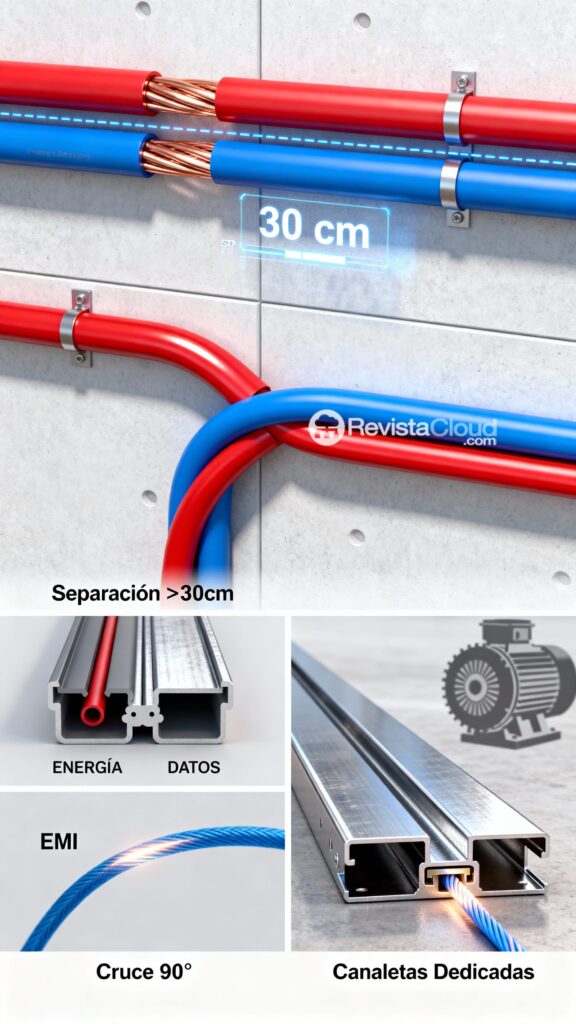⚠️ No matter how good your switches, routers, or network cables are. If you share the same pathway for electricity and data cables, you will encounter problems. This is not just an opinion; it’s mandated by the TIA/EIA-568 standards and supported by basic electromagnetic physics of electromagnetic interference (EMI).
The most common mistake in structured cabling
Many installations often “save space” by running everything in the same conduit: power and data. The result:
- Degradation of actual speeds compared to what was contracted.
- PCs losing network connectivity for seconds.
- Corrupted data packets that need retransmission.
- Random IP phone cuts.
- Robotic voice quality during video calls.
- WiFi access points disconnecting unexpectedly.
- Increased wear on switches and routers due to error correction.
The invisible issue is that electrical noise gradually degrades signal quality until user experience is compromised.
Why does this happen?
Cables, motors, and transformers generate electromagnetic fields. The higher the frequency, current, and voltage, the more “noisy” the environment becomes.
Copper data cables transmit very weak signals at high frequencies and are especially sensitive to this noise. When the signal-to-noise ratio (SNR) drops below acceptable levels, errors occur.

What international standards say
- TIA/EIA-568 (structured cabling) mandates physical separation between power and data.
- TIA-569-D (conduits) specifies minimum distances.
- ISO/IEC 11801 and EN 50173 (European standards) agree on these recommendations.
- The NEC (National Electrical Code) in the U.S. also requires separate conduits or specific distances.
Recommended separation distances
| Installation scenario | TIA/EIA-568 / ISO 11801 recommendation | NEC / EN 50173 | Remarks |
|---|---|---|---|
| Parallel to electrical wiring < 2 kVA | ≥ 30 cm | 30–50 cm | Typical offices and homes. |
| Parallel to electrical wiring > 2 kVA | ≥ 60 cm | 60–100 cm | Environments with machinery, data centers with power lines. |
| Crossing data and power cables | At 90° | At 90° | Crossings should always be at right angles to minimize coupling. |
| Shared conduit with metal partition | Allowed | Allowed | The partition must be grounded to serve as shielding. |
| Industrial environments with motors/variable speed drives | Optical fiber recommended | Optical fiber recommended | Shielded copper (STP/S/FTP) may be insufficient against extreme noise. |
| Metal trays with cover and proper grounding | May reduce distances | May reduce distances | Shielding works when properly grounded. |
Good practices to avoid EMI
📏 Physical separation
- At least 30 cm in parallel, 60 cm if high power.
- Always cross at 90° angles.
📦 Independent conduit routing
- Separate conduits and trays for data and power.
- Use metallic conduits with grounding in critical environments.
🔒 Shielding
- If space is limited, use STP or S/FTP cables.
- Connect patch panels, racks, and shields to ground.
🌐 Optical fiber
- The definitive solution in noisy industrial environments.
- Immune to interference and offers higher transmission capacity.
⚡ Additional protection
- Use surge protectors and EMI filters for sensitive equipment.
Real-world cases
- Office with mixed conduits: VoIP calls with random cuts and brief disconnections.
- Factory with motor drives: Unstable network, WiFi disconnects when machines start.
- School with old fluorescent lights: PCs lose connection when lights turn on.
In all cases, the problem was resolved by separating the pathways or switching to fiber optic.
The golden rule
👉 The cable route is as important as the cable itself.
Investing in a quality Cat 6A or Cat 7 is pointless if it’s installed right next to a 230 V cable.
Conclusion
The separation of electricity and data is not a matter of preference; it’s a technical and regulatory requirement. Respecting distances, using appropriate shielding, and planning channels from the start ensures fast, reliable, and secure networks. Ignoring this leads to noise, errors, and degradation that impact productivity and equipment lifespan.
Frequently Asked Questions (FAQ)
What is the minimum recommended distance between electrical and data cables?
30 cm in parallel with low loads. For high-power installations, at least 60 cm.
What should I do if I cannot separate power and data?
Use STP or S/FTP cables, grounded metallic conduits, and, if possible, opt for fiber optic.
Does fiber optic cable prevent electromagnetic interference?
Yes, it’s immune to EMI and the most robust option in industrial environments.
What standards should I follow in a professional installation?
The TIA/EIA-568, TIA-569-D, ISO/IEC 11801, and EN 50173 standards in Europe, as well as the NEC in the U.S., specify specific distance and conduit requirements.

